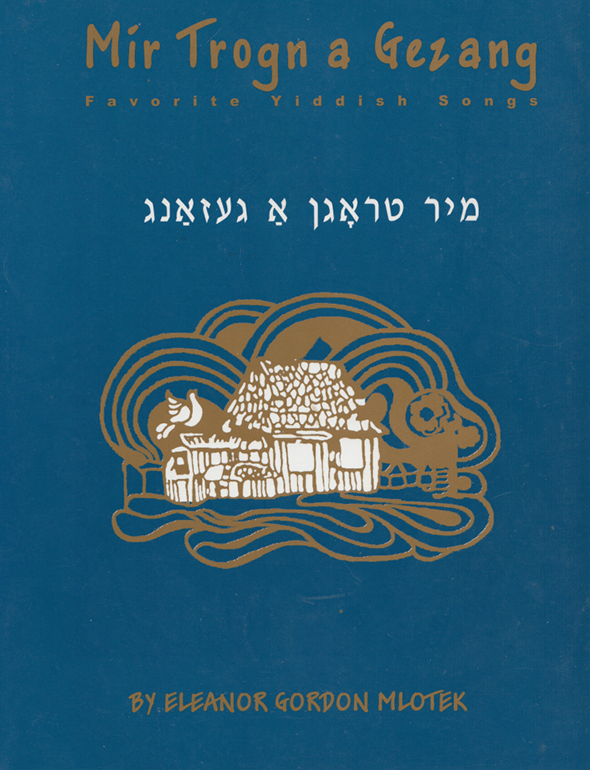
“Berele, my beloved
I have a request of you.”
“Perele, my beloved,
what is your request.”
“When with luck I have,
happily, a boy,
A want our child named
after my devout grandfather.”
“Why after your grandfather?
I do get a say, too.
You just named a girl
after your grandmother Leye.”
“Berele, my dear husband,
I want to remind you of something.”
“Perele, my dear wife,
what do you want to remind me?”
“You forget that our Leybke
is named for your grandfather,
why do you get the boys
and leave me the girls?”
“And you forget that for your father
our Nokhem is named,
and so takes after him –
not such a great sage.”
“Berele, my dear one,
I want to tell you something.”
“Perele, my dear one,
what do you want to tell me?”
“Why do we need to fight now,
let’s live long enough,
and then I will give the child a name
none other than grandfather’s.”
“Why fight now, in fact,
it’s useless to talk about it,
maybe we will actually have twins.”
“And they could even be girls.”
— Berele, mayn libinker,
Kh’hob tsu dir a bakoshe,
— Perele, mayn libinke,
Vos iz dayn bakoshe?
— Ven mit mazl ikh vel hobn
A yingele in freydn,
Vil ikh undzer kind zol heysn
Nokh mayn frumen zeydn.
— Far vos epes nokh dayn zeydn?
Kh’hob dokh oykh a deye.
Host dokh ersht gehat a meydl
Nokh dayn bobe Leye.
— Berele, mayn manele,
Kh’vil dikh epes dermonen-
— Perele, mayn vaybele,
Vos vilstu mikh dermonen?
— Du fargest, az undzer Leybke
Heyst shoyn nokh dayn zeydn,
Far vos kloybstu zikh di yungen,
Varfst mir tsu di meydn?
— Un du fargest, az nokh dayn tatn
Heyst dokh undzer Nokhem,
Er iz derfar in im gerotn-
Nisht keyn groyser khokhem.
— Berele, mayn tayerer,
Kh’vil dir epes zogn-
— Perele, mayn tayere,
Vos vilstu mir zogn?
— Vos zhe darf men itst zikh krign,
Lomir nor derlebn,
Vel ikh davke nokh mayn zeydn
S’kind a nomen gebn.
— Vos zhe take itst zikh krign
Un umzist tsu reydn,
Efsher vet gor zayn a tsviling-
S’ken gor zayn tsvey meydn.
— בערעלע, מײַן ליבינקער,
כ’האָב צו דיר א בקשה,
— פּערעלע, מײַן ליבינקע,
װאָס איז דײַן בקשה?
— װען מיט מזל איך װעל האָבן
אַ ייִנגעלע אין פֿרײדן,
װיל איך אונדזער קינד זאָל הײסן
נאָך מײַן פֿרומען זײדן.
— פֿאַר װאָס עפּעס נאָך דײַן זײדן?
כ’האָב דאָך אױך א דעה,
האַסט דאָך ערשט געהאט א מײדל
נאָך דײַן באָבע לאה.
— בערעלע, מײן מאַנעלע,
כ’װיל דיך עפּעס דערמאַנען —
— פּערעלע, מײַן װײַבעלע,
װאָס װילסטו מיך דערמאָנען?
— דו פֿאַרגעסט, אַז אונדזער לײבקע
הײסט שױן נאָך דײַן זײדן,
פֿאַר װאָס קלױבסטו זיך די יונגען,
װאַרפֿסט מיר צו די מײדן?
— און דו פֿאַרגעסט, אַז נאָך דײַן טאַטן
הײסט דאַך אונדזער נחום,
ער איז דערפֿאַר אין אים געראָטן —
נישט קײן גרױסער חכם.
— בערעלע, מײַן טײַערער,
כ’װיל דיר עפּעס זאָגן —
— פּערעלע, מײַן טײַערע,
װאָס װילסטו מיר זאָגן?
— װאָס זשע דאַרף מען איצט זיך קריגן,
לאָמיר נאָר דערלעבן,
װעל איך דװקא נאָך מײַן זײדן
ס’קינד א נאָמען געבן.
— װאָס זשע טאַקע איצט זיך קריגן
און אומזיסט צו רײדן,
אפֿשר װעט נאָר זײַן אַ צװילינג —
ס’קען גאָר זײַן צװײ מײדן.
Song Title: Nokh a Glezele Tey

First published in 1972, Mir Trogn A Gezang: Favorite Yiddish Songs was reprinted six more times (in 1977, 1982, 1985, 1987, 1988, 2000) due to popular demand. The songs in this anthology represent a sampling of beloved folk and well-known Yiddish songs, many of which are scattered in various song collections; some appear in very rare and inaccessible collections; and some were never before published. Folk songs comprise about a third of this volume and were selected mainly on the basis of popularity and sometimes for their historic significance. Needless to say, they are only representative of the vast, rich treasure of Yiddish folk material. The selection was made not only on the basis of personal preference, but in the knowledge they are favorites of many who sing these songs. Most of the songs represent the repertoire that was sung at Yiddish summer camps, May 1st demonstrations and at social gatherings. Many songs were introduced to American Jewry by Jewish immigrants who came to the United States after World War II, for whom these songs had been favorites in Poland and other East European communities destroyed by the Nazis.